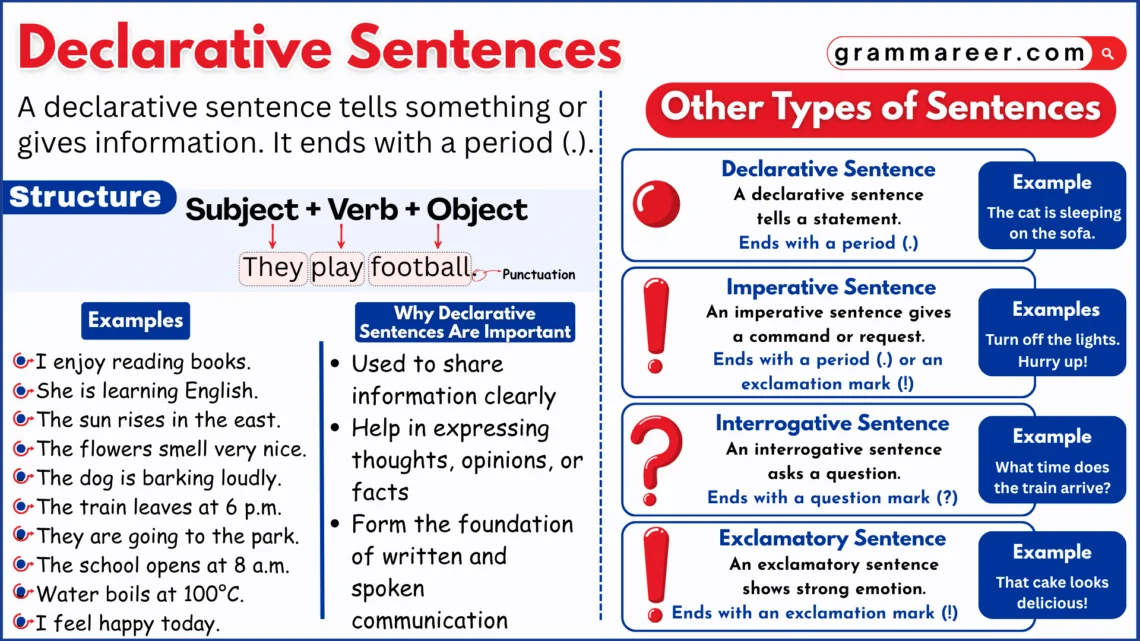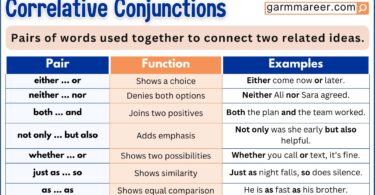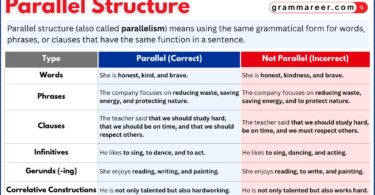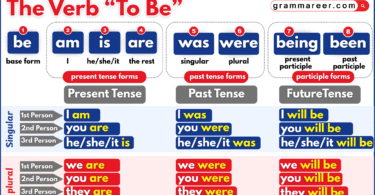Have you ever said something just to share information — like The sky is blue or I’m feeling hungry? That’s a declarative sentence! We use this type of sentence whenever we want to tell something, not ask a question or give a command.
In this article, we’ll learn what a declarative sentence is, how it works, and why it’s the most common type of sentence in English. We’ll also look at some simple examples to make everything super easy to understand.
Table of Contents
What is a Declarative Sentence?
A declarative sentence is the kind of sentence we use when we want to share information or express an idea. It’s one of the four main types of sentences in English and the others are interrogative, imperative, and exclamatory sentences.
In simple words, a declarative sentence tells something. It could be a fact, an opinion, or just an everyday statement like The Earth orbits the sun or I enjoy reading books.
Every declarative sentence has two main parts: a subject and a predicate. The subject tells us who or what the sentence is about, and the predicate tells us what’s happening or what the subject is doing. For example, in the sentence She sings beautifully, she is the subject, and sings beautifully is the predicate.
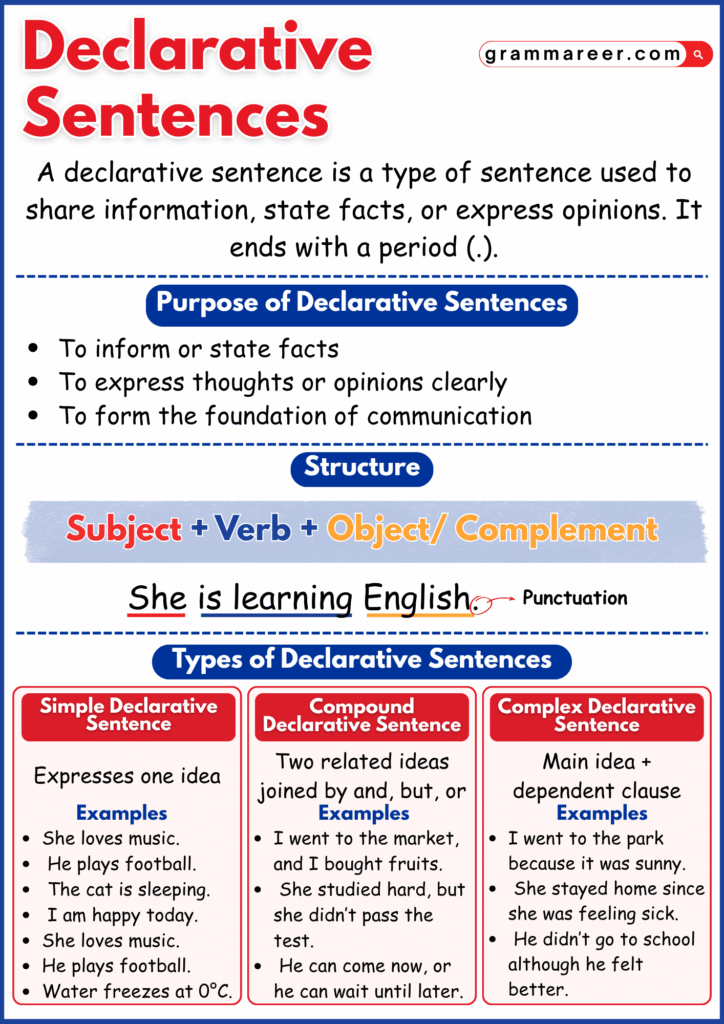
How to Write a Declarative Sentence?
Writing a declarative sentence is something we all do every day, often without even realizing it. Let’s go over a few simple points to understand how we can write them correctly.
• End with a Period (.):
A declarative sentence always ends with a period because it simply shares information. It doesn’t ask a question or show strong emotions.
Example:
- We are learning English grammar.
If we change the period to an exclamation mark like “We are learning English grammar!” the tone suddenly becomes emotional, and it turns into an exclamatory sentence. So, when we write declarative sentences, we keep the punctuation calm and clear.
• Share Information, Don’t Command:
Declarative sentences are used to tell something like a fact, an opinion, or an idea. They don’t give orders or make requests.
Example:
- Our teacher explains the lesson clearly.
If we say, Please explain the lesson again, it becomes an imperative sentence because we’re giving a request. Declarative sentences, on the other hand, just pass on information.
• The Subject Comes Before the Verb:
In a declarative sentence, the subject usually comes before the verb. This makes the sentence sound natural and easy to follow.
Example:
- We enjoy learning new words.
If we change it to Do we enjoy learning new words?, it becomes an interrogative sentence (a question). That’s why keeping the subject before the verb is important in declarative sentences.
• Keep the Tone Clear and Simple:
Declarative sentences are the most common type of sentence in English. We use them in writing, in conversation, and in daily communication. They make our thoughts sound clear, natural, and complete.
Types of Declarative Sentences with Examples
Declarative sentences aren’t all the same. Some are short and simple, while others can be longer and more detailed. The difference depends on how many clauses a sentence has. A clause is just a group of words with a subject and a verb.
Let’s look at the four main types of declarative sentences and see how they work with some easy examples.
1. Simple Declarative Sentence:
A simple declarative sentence has only one independent clause — one complete idea. It’s short, clear, and easy to understand.
Example:
- The sun is shining.
- We love reading stories.
2. Compound Declarative Sentence:
A compound declarative sentence has two or more independent clauses joined by words like and, but, or, so. These connecting words are called conjunctions.
Example:
- The sun is shining, and the birds are singing.
- We wanted to go out, but it started to rain.
3. Complex Declarative Sentence:
A complex declarative sentence has one main clause and one or more dependent clauses — parts that add extra information but can’t stand alone.
Example:
- When it rains, we stay inside and read books.
- We smiled because the plan worked perfectly.
4. Compound-Complex Declarative Sentence:
This one mixes both compound and complex structures. It has two or more main clauses and at least one dependent clause.
Example:
- When the sun rises, the birds start singing, and we wake up early.
- We cooked dinner together, and everyone laughed while we ate.
In short, declarative sentences can be simple or detailed, depending on how much information we want to share. The more clauses we add, the more ideas we can express in one sentence!
Declarative Sentence Structure and Word Order
When we write or speak in English, word order plays a big role in making our sentences clear. In declarative sentences, the structure is usually simple and direct — just the way we talk every day.
1. Basic Word Order
The usual word order in a declarative sentence is:
- Subject → Verb → Object
That means we start with who or what (the subject), then say what they’re doing (the verb), and finally to whom or what the action is happening (the object).
Example:
- We play football in the park every evening.
- Structure: Subject → Verb → Object → Place → Time
This pattern helps our sentences sound natural and easy to understand.
2. Flexibility in Word Order
Of course, not every declarative sentence follows the same pattern strictly. We can move parts around for style or emphasis, especially when we use phrases that show time or condition.
Example:
- Before the sun rises, the birds start singing.
Here, we began with a time phrase (Before the sun rises), but notice how the main part (the birds start singing) still keeps the subject-verb order. That’s the key feature of declarative sentences — the subject always comes before the verb in the main clause.
3. Comparing with Interrogative Sentences
In declarative sentences, the word order stays subject-verb, but in questions (interrogative sentences), it switches to verb-subject.
Examples:
- Rachel is Irish. (Declarative – Subject first)
- Is Rachel Irish? (Interrogative – Verb first)
In short, declarative sentences usually follow a calm, clear structure: subject first, verb second. It’s the simplest and most natural way to share information in English.
Difference Between Declarative and Interrogative Sentences
Declarative sentences are statements that tell us something, while interrogative sentences are questions that ask for information. Both are common in everyday English but serve very different purposes.
| Declarative Sentence | Interrogative Sentence |
| A declarative sentence gives information or expresses an idea clearly. | An interrogative sentence asks a question and expects an answer. |
| Structure: Subject + Verb + Object | Structure: Verb + Subject + Object |
| • Example: We enjoy learning new things every day. | • Example: Do we enjoy learning new things every day? |
Difference Between Declarative and Exclamatory Sentences
Declarative sentences simply state something, while exclamatory sentences show strong feelings like joy, surprise, or anger. The only real difference is the emotion and punctuation.
| Declarative Sentence | Exclamatory Sentence |
| A declarative sentence gives a simple fact or opinion. | An exclamatory sentence shows sudden emotion or excitement. |
| Structure: Subject + Verb + Object | Structure: Subject + Verb + Object + (!) |
| • Example: Our trip was amazing. | • Example: Our trip was amazing! |
Difference Between Declarative and Imperative Sentences
Declarative sentences tell something, while imperative sentences tell someone to do something. Imperatives are often used for giving instructions, advice, or commands.
| Declarative Sentence | Imperative Sentence |
| A declarative sentence shares information or an idea. | An imperative sentence gives a command, request, or suggestion. |
| Structure: Subject + Verb + Object | Structure: Verb (subject “you” is understood) |
| • Example: We follow the rules carefully. | • Example: Follow the rules carefully. |
Why Declarative Sentences Matter?
Declarative sentences might look simple, but they play a huge role in how we communicate. Almost everything we say or write in English is a declarative sentence. That’s why understanding how they work—and how to use them correctly—is so important for both learners and teachers.
One common mistake people make is confusing declarative sentences with questions. Sometimes, a sentence may sound like a question, but it’s not actually one.
| ❌ Wrong | ✔️ Correct |
| • The boss asked when the meeting starts? • I wonder if she’ll come today? | • The boss asked when the meeting starts. • I wonder if she’ll come today. |
Notice how the word order stays the same in each sentence: subject first, then verb. That’s the typical structure of a declarative sentence.
Now, let’s look at indirect questions. The same rule applies—we still use declarative word order, not question word order.
| ❌ Wrong | ✔️ Correct |
| • I want to know where is he. | • I want to know where he is. |
So, even though you’re talking about a question, the sentence itself is still declarative. Keeping the right word order makes your sentences sound natural and grammatically correct.
Examples of Declarative Sentences
- The sun rises in the east.
- She doesn’t like cold coffee.
- We are learning English every day.
- It looks like it’s going to rain.
- My brother studies at a university in Lahore.
- They didn’t finish their homework on time.
- The dog is sleeping on the sofa.
- I love reading mystery novels at night.
- Our teacher explained the topic very clearly.
- He isn’t feeling well today.
- The children are playing football in the park.
- We watched a movie after dinner.
- She always drinks coffee before work.
- The shop doesn’t open on Sundays.
- It feels cold this morning.
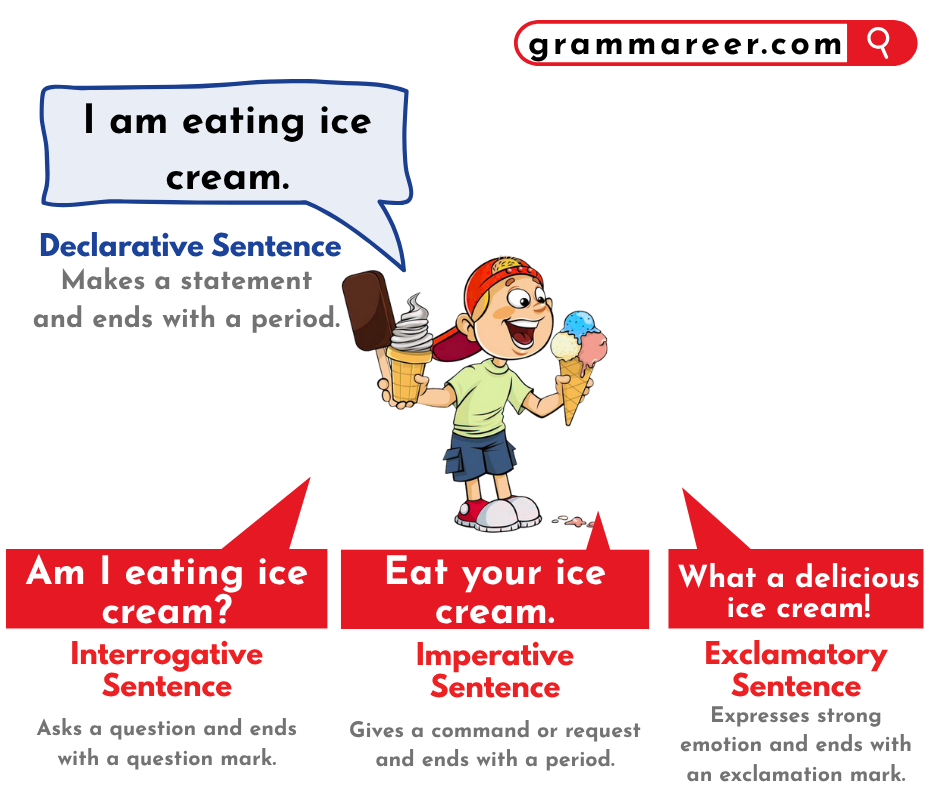
FAQs About Declarative Sentences
A declarative sentence is a sentence that gives information or makes a statement. It can share a fact, opinion, or idea in a calm and direct way. For example, The sky is blue or I like pizza — both tell something without asking or commanding.
We use declarative sentences whenever we want to share information or express a thought. The sentence usually follows this order: Subject + Verb + Object, and it always ends with a period (.). For instance,
• She reads every night
• We are learning English.
Here are a few examples you might hear every day:
• He loves playing football.
• We are ready for the trip.
• The flowers smell wonderful.
• It doesn’t look good today.
• I finished my homework.
You May Also Like

